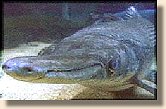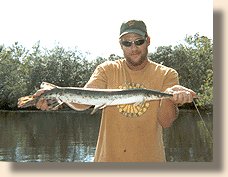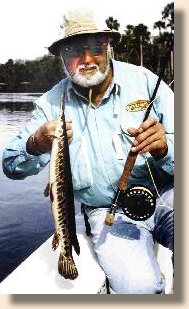Breaking a World Record on Fly for Gar has been a long time passion
of mine. I've found some exceptional locations that harbor gar in the
Volusia and Flagler County backwaters. Gar is not as elusive as you
might think. Find a warm stretch of fast moving water under trees and
brush that line a creeks banks, and you'll find gar. They seem to congregate
often near the nests of alligators and eat some of the same small live and dead
fish and reptiles. The most common species in Florida include the Alligator
Gar (All line class, World Record in LA is 9 feet by Beth who was out fishing
for Redfish), Florida Gar, and Long Nose Gar.
 Gar, like the sea lamprey and sturgeon, are also remnants from primitive times.
Their skeletons are part cartilage and part bone. They have long jaws, the snout
extending far forward resembling a beak. Both upper and lower jaws are lined
with strong, sharp teeth. Their body shape is long and more or less cylindrical.
Gars have modified heterocercal tails and hard, diamond-shaped ganoid scales.
Always keep your hands away from a Gar's mouth. They can swing around
with lightning speed. Their jaws lock when shut and a finger can become
severed with one bite.
Gar, like the sea lamprey and sturgeon, are also remnants from primitive times.
Their skeletons are part cartilage and part bone. They have long jaws, the snout
extending far forward resembling a beak. Both upper and lower jaws are lined
with strong, sharp teeth. Their body shape is long and more or less cylindrical.
Gars have modified heterocercal tails and hard, diamond-shaped ganoid scales.
Always keep your hands away from a Gar's mouth. They can swing around
with lightning speed. Their jaws lock when shut and a finger can become
severed with one bite.
They spawn in the spring by broadcasting their adhesive eggs in shallow water
where the eggs attach to vegetation. No parental care is given the eggs or young.
In addition to gill breathing, gars have a unique air bladder that permits them
to obtain oxygen from the air. This air-breathing ability enables gar to survive
in polluted waters where other fish species cannot live.
Except for some of us fools, Gar are seldom caught by fishermen and are generally
considered a nuisance. Their scales have sharp edges, so they should be handled
with gloves. Gar eggs (roe) are extremely toxic, but their rather dry flesh is
edible. They are very difficult to prepare and are seldom eaten.

The key to catching gar on fly is finding the right pattern. Some years ago,
with master fly tier and friend Ken Bay, we set out to try a couple of theories
on flies. We wanted a fly that could be dislodged with no harm to the fish or
ourselves. Ken made me a fly on 100-pound monocore using a split ring.
The body was white super hair and white marabou (key ingredient). We
found this really effective in catching the gar, relying on its powerful jaws to
shut down and hold the marabou and monocore shank. The problem came
in bringing the gar to the boat. If you lifted the fish, it would just slide out
of the fly, more or less flossing its teeth. We came up with an alternative
that worked better but required a #4 hook. This allowed us to catch and
boat the gar but he couldn't dislodge the hook.
Last year while experimenting with the Hot Lips fly, we changed the underbody
to include a section of brown ice chenille and a big bunch of white marabou on
a 3/0 hook. That seemed to work better because now you could remove the
hook without injury to either fish or angler. While out one Sunday with a charter,
we got lucky.

That's a Florida Gar Bard Livesey is carefully holding for the camera. We have
filed the paperwork with IGFA and expect this to be registered as a new World
Record for Long Nose Gar on Fly. Garfish are an exceptional fighting fish found
here on the boundary between fresh and saltwater. The river estuary plays host
to a diverse ecosystem of wildlife, aquatic fish, plants and birds.
Brad and I were fishing a mangrove line along the south side of my favorite island
hammock. He was doing well catching nice Snook, one of which decided to keep
the Green/red ultra hair bug. Luckily I have a box full of these flies. But, for those
of you who know me, I like changing flies. If one is working well for a while then
try something different. Change is good!
So I picked out an oil-colored Hot Lips fly with a white marabou tail. Brad's casts
where picture book perfect. Under a large overhanging cedar tree we noticed
some thrashing in the water.
"Baby Tarpon," I thought. OK, it is kind of early but that could work. I really
wanted someone to catch a tarpon on that Hot Lips fly.
"Brad, cast half way in under that branch," I whispered.
He placed the fly as softly as if he had placed it on the water with his hands. BAM!
The fly was engulfed by a big, ugly, beauty of a gar that managed to drive the
hook through the lower jaw and back up into his mouth. He fought hard.
Rolling, walking and running, the gar made thrashing moves to get free of
the line. Once he dislodged the hook, the gar would not give up the
marabou. So we let him have it. He didn't even seem one bit phased
by the situation and just swam away.
You can imagine the care we took in de-hooking this fish. Garfish are tough
to handle because of their long snout and sharp teeth. Identified, weighed,
and measured, the fly line is on its way to IGFA.
Catch/Release: it's the right thing to do.
~ Doug.
About Doug:
Doug is a USCG Licensed Captain and fly-fishing guide from New Smyrna Beach, FL
a member of CCA, FFF, AFF, APCA, FOWA, the Action Craft Saltwater Team,
and the Orvis and Redington Pro-Guide Program. He can be reached at 386-679-5814.
|



